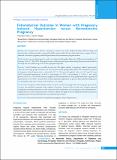Please use this identifier to cite or link to this item:
https://hdl.handle.net/20.500.14356/1353Full metadata record
| DC Field | Value | Language |
|---|---|---|
| dc.contributor.author | Thakur, Amarnath | - |
| dc.contributor.author | Dangal, Ganesh | - |
| dc.date.accessioned | 2023-05-08T09:41:52Z | - |
| dc.date.available | 2023-05-08T09:41:52Z | - |
| dc.date.issued | 2019 | - |
| dc.identifier.citation | ThakurA., & DangalG. (2020). Fetomaternal Outcome in Women with Pregnancy Induced Hypertension versus Normotensive Pregnancy. Journal of Nepal Health Research Council, 17(4), 495-500. https://doi.org/10.33314/jnhrc.v17i4.2103 | en_US |
| dc.identifier.issn | Print ISSN: 1727-5482; Online ISSN: 1999-6217 | - |
| dc.identifier.uri | http://103.69.126.140:8080/handle/20.500.14356/1353 | - |
| dc.description | Original Article | en_US |
| dc.description.abstract | Abstract Background: A hypertensive disorder in pregnancy comprises one of the deadly triad along with hemorrhage and infection-that contributes greatly to maternal morbidity and mortality. The aim of this study was to compare the feto-maternal outcome in pregnancy induced hypertension with normotensive pregnant women. Methods: A cross sectional prospective study was conducted in Paropakar Maternity and Women’s Hospital from 1st February 2018 to 1st May 2018. All pregnant women seeking help for hypertension during this period was included in the study and were followed up to six weeks of postpartum period. Results: Total 40 patients were enrolled in each arm. The highest number of pregnancy induced hypertension cases was seen in age group 20-24years (32.5%) and were mostly primigravidas (60%). The commonest symptom in Pregnancy induced hypertension was headache 47.5 %. The mean hemoglobin value was 11.91 gm/dl, mean SGPT (Gestational hypertension 25.44 IU/L, preeclampsia 55.25 IU/L and eclampsia 32.17 IU/L) and mean platelet count was 1, 95,140 lakh/cumm in pregnancy induced hypertension. Mean prothrombin time in gestational hypertension was 13.78±0.7 seconds. Most common maternal complication was preterm labor and fetal complication was prematurity. The most common mode of delivery was vaginal. Conclusions: Pregnancy induced hypertension was more common in primigravida with young age group of 20-24 years and presented commonly with complain of headache. Preterm labor was the most common maternal complication similarly prematurity was the commonest fetal complication seen in pregnancy induced hypertension. Vaginal delivery was the commonest mode of delivery. Blood investigation showed significant thrombocytopenia in eclampsia and decreased prothrombin time in gestational hypertension. Keywords: Fetal outcome; maternal complications; pregnancy induced hypertension | en_US |
| dc.language.iso | en | en_US |
| dc.publisher | Nepal Health Research Council | en_US |
| dc.relation.ispartofseries | Oct-Dec, 2019;2103 | - |
| dc.subject | Fetal outcome | en_US |
| dc.subject | Maternal complications | en_US |
| dc.subject | Pregnancy induced hypertension | en_US |
| dc.title | Fetomaternal Outcome in Women with Pregnancy Induced Hypertension versus Normotensive Pregnancy | en_US |
| dc.type | Journal Article | en_US |
| local.journal.category | Original Article | - |
| Appears in Collections: | Vol. 17 No. 4 Issue 45 Oct-Dec 2019 | |
Files in This Item:
| File | Description | Size | Format | |
|---|---|---|---|---|
| 2103-Manuscript-13235-1-10-20200121.pdf | Fulltext Download | 799.41 kB | Adobe PDF |  View/Open |
Items in DSpace are protected by copyright, with all rights reserved, unless otherwise indicated.
